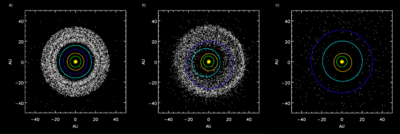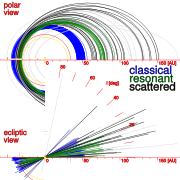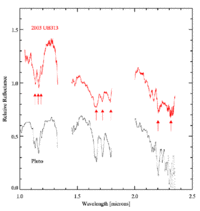Scattered disc
2008/9 Schools Wikipedia Selection. Related subjects: Space (Astronomy)
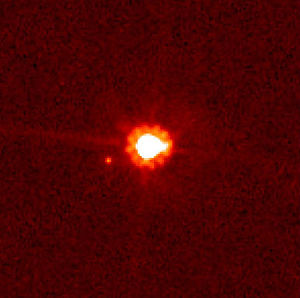
| TNOs and similar bodies |
|---|
*Trans-Neptunian dwarf planets are " plutoids"
|
The scattered disc (or scattered disk) is a distant region of the Solar System, thinly populated by icy minor planets known as scattered disc objects (SDOs), a subset of the broader family of trans-Neptunian objects (TNOs). The scattered disc consists of those objects that are capable of being gravitationally perturbed by the planet Neptune, with large, highly eccentric and inclined orbits that have perihelion distances near 35 astronomical units (AU). Extreme eccentricity and high inclination appear to be the norm for orbits in the region, but the orbital eccentricity alone is the distinctive attribute of the family of objects in the scattered disc. The eccentric orbits are believed to be the result of gravitational " scattering" by the gas giants.
The nearest distance from the Sun approached by scattered objects is less than 40 AU, within the range of Neptune's influence, but the objects' farthest distances from the Sun can extend well beyond 100 AU. This makes scattered objects "among the most distant and cold objects in the solar system". Eris, the largest dwarf planet in the Solar System, lies within the scattered disc.
The innermost portion of the scattered disc overlaps with the Kuiper belt, but its outer limits extend much farther away from the Sun and farther above and below the ecliptic than the belt proper. Although the numbers of objects in the Kuiper belt and the scattered disc are believed to be more or less equal, observational bias due to their farther distance means that far fewer scattered disc objects have been observed to date.
Due to its unstable nature, the scattered disc is believed to be the place of origin for most periodic comets observed in the Solar System. The centaurs, a population of icy bodies between Jupiter and Neptune, are believed to be an intermediate stage between the scattered disc and the periodic comets. Many Oort cloud objects are also believed to have originated in the scattered disc.
Discovery
The first scattered disc object to be recognized as such was (15874) 1996 TL66, originally identified in 1996 by astronomers based at Mauna Kea in Hawaii. Three more were identified by the same survey in 1999: 1999 CV118, 1999 CY118 and 1999 CF119. The first object presently classified as a scattered disc object to be discovered was (48639) 1995 TL8, found in 1995 by Spacewatch. Since then, several more scattered disc objects have been discovered, including the 2007 UK126 (discovered by Schwamb, Brown, and Rabinowitz), (84522) 2002 TC302 ( NEAT), Eris (Brown, Trujillo, and Rabinowitz) Sedna (Brown, Trujillo, and Rabinowitz) and 2004 VN112 ( Deep Ecliptic Survey), to name a few.
Formation
The scattered disc is still poorly understood, since no model of the formation of the Kuiper belt and the scattered disc has yet been proposed that explains all their observed properties.
Prevailing astronomical opinion suggests the scattered disc was formed when Kuiper belt objects (KBOs) were "scattered" by gravitational interactions with the outer planets, principally Neptune, into highly eccentric and inclined orbits. This process would have been gradual, taking place over the course of billions of years.
However, alternative hypotheses suggest different mechanisms for the scattering. Computer simulations show the Kuiper belt to have been strongly influenced by Jupiter and Neptune, and also suggest that neither Uranus nor Neptune could have formed in situ beyond Saturn, as too little primordial matter existed at that range to produce objects of such high mass. Instead, these planets are believed to have formed closer to Jupiter, but to have been flung outwards during the course of the Solar System's early evolution. Work in 1984 by Fernandez and Ip suggests that exchange of angular momentum with the scattered objects can cause the planets to drift. Eventually, the orbits shifted to the point where Jupiter and Saturn existed in an exact 2:1 resonance; Jupiter orbited the Sun twice for every one Saturn orbit. The gravitational pull from such a resonance ultimately disrupted the orbits of Uranus and Neptune, causing them to switch places and for Neptune to travel outward into the proto-Kuiper belt, sending it into temporary "chaos". As Neptune traveled outward, it excited and scattered many TNOs into higher and more eccentric orbits. This alternate model minimizes the influence of gravitational scattering, suggesting instead that as much as 90% of the objects in the scattered disc may have been "promoted into these eccentric orbits by Neptune's resonances during the migration epoch...[therefore] the scattered disc might not be so scattered."
Subdivisions of trans-Neptunian space
Known trans-Neptunian objects are often divided into two subpopulations: the Kuiper belt and the scattered disc. A third reservoir of trans-Neptunian objects, the Oort cloud, is believed to exist, although no confirmed direct observations of the Oort cloud have been made. Some researchers further suggest a transitional space between the scattered disc and the inner Oort cloud, populated with " detached objects".
It is not only the boundaries of the scattered disc that are unclear: there is an emerging sense that the centaur class of icy planetoids may simply be objects just like SDOs that were knocked inwards from the Kuiper belt rather than outwards, making them "cis-Neptunian" rather than trans-Neptunian scattered disc objects. (Remo notes that Cis-Neptunian bodies "include terrestrial and large gaseous planets, planetary moons, asteroids, and main-belt comets within Neptune's orbit.") Indeed, some objects like (29981) 1999 TD10 blur the distinction, and the Minor Planet Centre (MPC) now lists centaurs and SDOs together.
Scattered disc versus Kuiper belt
The innermost portion of the scattered disc overlaps with the Kuiper belt, but its outer limits extend much farther away from the Sun and farther above and below the ecliptic than the belt proper. The Kuiper belt consists of objects in relatively stable orbits beyond the reach of Neptune. The difference between the Kuiper belt and the scattered disc is not clearcut, and many astronomers see the scattered disc not as a separate population but as an outward region of the Kuiper belt. In recognition of this blurring of categorisation, some scientists use "scattered Kuiper belt object" (or SKBO) for bodies of the scattered disc.
Morbidelli and Brown suggest that an initial understanding of the difference between objects in the Kuiper belt and scattered objects could be that the latter bodies "are transported in semi-major axis by close and distant encounters with Neptune", while the former experienced no such close encounters. This initial delineation is inadequate over the age of the solar system, however, since bodies "trapped in resonances" could "pass from a scattering phase to a non-scattering phase (and vice versa) numerous times". That is, trans-Neptunian objects could travel back and forth between the Kuiper belt and the scattered disc over time. Therefore they choose instead to define the regions, rather than the objects, defining the scattered disc as "the region of orbital space that can be visited by bodies that have encountered Neptune" within the radius of a Hill sphere, and the Kuiper belt as its "complement... in the a > 30 AU region".
Detached objects
Although the trans-Neptunian object 90377 Sedna is officially counted as a scattered disc object by the MPC, its discoverer Michael E. Brown has suggested that, because its perihelion distance of 76 AU is too distant to be affected by the gravitational attraction of the outer planets, it should be considered an inner Oort cloud object rather than a member of the scattered disc. Thus, an object with a perihelion greater than 40 AU, beyond the reach of Neptune, could be classified as outside the scattered disc.
If Sedna is beyond the scattered disc, it may not be unique: 2000 CR105 (discovered before Sedna) and 2004 VN112 with a perihelion too far away from Neptune to be influenced by it, led to a discussion among astronomers about a new minor planet set, called the Extended scattered disc (E-SDO). 2000 CR105 may also be an inner Oort cloud object or (more likely) a transitional object between the scattered disc and the inner Oort cloud. More recently, these objects have been referred to as "detached", or Distant Detached Objects (DDO).
There are no clear boundaries between the scattered and detached regions. Such objects have orbits which cannot be created by Neptune scattering. Instead, a number of explanations have been put forward including a passing star or a distant, planet-sized object. The classification suggested by Deep Ecliptic Survey team introduces a formal distinction between Scattered-Near objects (which could be scattered by Neptune) from Scattered-Extended objects (e.g. 90377 Sedna) using Tisserand's parameter value of 3.
Orbits
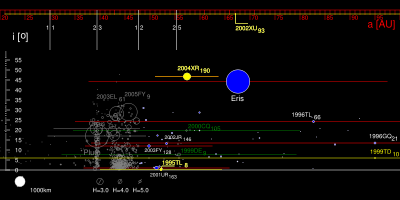
The Kuiper belt is a relatively thick torus of space, extending from about 30 to 50 AU with member-objects such as classical Kuiper belt objects (or "cubewanos") locked in autonomously circular orbits, while the orbits of plutinos and twotinos are mildly-elliptical and resonant. The scattered disc is by comparison a much more erratic milieu. Scattered objects' orbits can be inclined as much as 45 degrees from the ecliptic. Orbital simulations show scattered disc object orbits may well be erratic and unstable and that the ultimate fate of these objects is to be either permanently ejected from the core of the Solar System into the Oort cloud or beyond, or to be sent into the inner Solar System to become a short-period comet.
Typically, the scattered disc objects are characterized by orbits with medium and high eccentricities with a semi-major axis greater than 50 AU, but their perihelia bring them to 34 AU, within influence of Neptune. Those objects in resonant orbits with Neptune (such as Plutinos, which orbit the Sun twice for every three Neptune orbits) can approach the planet's orbit more closely, as Neptune cannot come close to them. Having a perihelion of 35 AU is actually one of the defining characteristics of scattered objects, as it allows Neptune to exert its gravitational influence.
The classical objects (cubewanos) are very different from the scattered objects: more than 30% of all cubewanos are on low inclination, near circular orbits and their eccentricity peaks at 0.25. While classical objects seldom possess eccentricities over 0.2, scattered objects possess eccentricities ranging from 0.2 to as much as 0.8.
Composition
Scattered objects, like other trans-Neptunian objects, have low densities and are composed largely of frozen volatiles such as water and methane. Spectral analysis of selected Kuiper belt and scattered objects has revealed signatures of similar compounds. Both Pluto and Eris, for instance, show signatures for methane.
Astronomers originally supposed that the trans-Neptunian population would show a similar red surface colour, as they were all believed to have originated in the same region and to have been subject to the same physical processes. Specifically, it was believed that all would possess great amounts of surface methane, which would be chemically altered into complex organic molecules by energy from the Sun. This resultant material would absorb blue light, creating a reddish hue. Most classical objects display this expected colour; however, scattered objects do not. Rather, scattered objects present a far more neutral, white or greyish appearance. One possible explanation for this variation in colour is exposure of whiter subsurface layers by impacts. Another is that the scattered objects' greater distance from the Sun creates a composition gradient, such as is seen in the different compositions of the terrestrial and gas giant planets. Mike Brown, discoverer of the scattered object Eris, suggests that a possible reason for its paler colour is that, at its current distance from the Sun, its atmosphere of methane is frozen to the surface, creating an inches-thick layer of bright white ice. Pluto, conversely, is closer to the Sun, and so will retain its nitrogen atmosphere until its orbit takes it far enough from the Sun for it to freeze.
Comets
Although the Kuiper belt was initially believed to be the source of the Solar System's ecliptic comets, studies of the region since 1992 has revealed that what is now called the Kuiper belt is relatively dynamically stable, and that it is the more dynamic scattered disc that is their true place of origin.
Comets in the Solar System can be loosely divided into two categories: short-period and long period. Long period comets are believed to originate in the Oort cloud. There are two major categories of short-period comets: Jupiter-family comets and Halley-family comets. The latter group, which is named for its prototype, Halley's Comet, are believed to have emerged from the Oort cloud but to have been drawn into the inner Solar System by the gravity of the giant planets. It is the former type, the Jupiter family, that are believed to have originated from the scattered disc. The centaurs are thought to be a dynamically intermediate stage between the scattered disc and the Jupiter family.
Despite the fact that many are universally thought to have hailed from the scattered disc, there exist a wide array of differences between SDOs and Jupiter-family comets. Although the centaurs share a reddish or neutral coloration with many SDOs, the nuclei of comets are far bluer, indicating a fundamental chemical or physical difference. The current hypothesis is that comet nuclei are resurfaced as they approach the Sun by subsurface materials which subsequently bury the older material.
